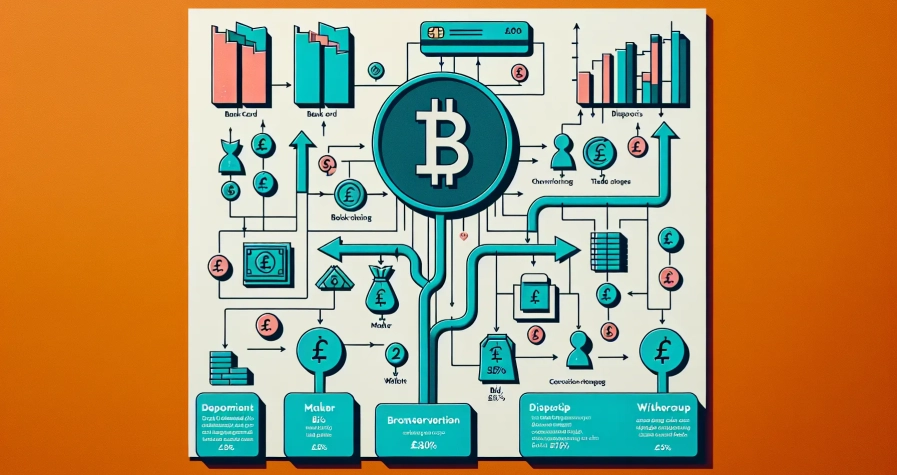If you’ve been following cryptocurrency news, you’ve probably encountered the term “fork” numerous times. These aren’t the utensils you use for dinner – they’re fundamental changes to blockchain protocols that can dramatically impact your crypto investments and the entire digital currency landscape.
Crypto forks represent crucial moments when blockchain networks evolve, split or upgrade their underlying rules. They’re essentially code changes that alter how a cryptocurrency operates, and understanding them is vital for anyone serious about navigating the crypto world effectively.
Whether you’re a seasoned trader or just starting your crypto journey, grasping the difference between hard forks and soft forks will help you make informed decisions. These protocol changes can create new cryptocurrencies, affect coin prices and influence the future direction of blockchain networks you’re invested in.
What Are Cryptocurrency Forks?
Cryptocurrency forks represent fundamental changes to a blockchain’s underlying protocol rules that create new pathways for network evolution. These modifications occur when developers implement updates that alter how the blockchain operates, processes transactions, or validates blocks.
A fork essentially creates a divergence point where the blockchain splits into two separate paths – one following the original rules and another adhering to the new protocol. This split happens when network participants must choose between maintaining the existing system or adopting the updated version.
The cryptocurrency community uses the term “fork” because the blockchain’s progression resembles a fork in the road where one path divides into multiple directions. Each direction represents a different set of protocol rules that govern how the network functions moving forward.
Blockchain networks implement forks for various reasons including security improvements, scalability enhancements, bug fixes, and feature additions. Bitcoin’s Segregated Witness (SegWit) implementation and Ethereum’s transition to proof-of-stake represent prominent examples of significant protocol changes through forking mechanisms.
The technical process involves miners, validators, and nodes updating their software to recognise new rules. Network consensus determines which version gains adoption, with the majority of participants typically supporting the fork that offers the most beneficial improvements to the ecosystem.
Your cryptocurrency holdings may be affected differently depending on the type of fork implementation. Some forks create entirely new cryptocurrencies, whilst others simply upgrade the existing network without generating additional tokens.
Understanding fork mechanics helps you navigate potential market volatility and investment opportunities that arise during these protocol transitions. The cryptocurrency market often experiences price fluctuations as traders and investors react to fork announcements and implementations.
Why Do Crypto Forks Happen?
Crypto forks emerge from three primary catalysts that drive blockchain evolution and adaptation. Understanding these underlying reasons helps you anticipate when networks might undergo significant changes and how they’ll impact your cryptocurrency investments.
Protocol Upgrades and Improvements
Protocol upgrades represent the most common driver behind crypto forks when blockchain networks require fundamental enhancements. These improvements address limitations in scalability, transaction speed, or consensus mechanisms that can’t be resolved through minor updates. Ethereum’s transition from proof-of-work to proof-of-stake through “The Merge” exemplifies how forks enable major protocol overhauls. You’ll encounter these upgrades when networks add new features like smart contract functionality, implement layer-2 scaling solutions, or optimise block validation processes. Developers initiate these forks to maintain competitiveness in the rapidly evolving cryptocurrency landscape where technological advancement directly correlates with network adoption and value retention.
Community Disagreements
Community disagreements create contentious forks when stakeholders hold conflicting visions for a blockchain’s future direction. These philosophical or technical disputes often centre around governance structures, development priorities, or fundamental protocol changes. Bitcoin Cash’s 2017 split from Bitcoin illustrates how disagreements over block size limits can permanently divide communities into separate networks. You witness these forks when mining pools, developers, and users fail to reach consensus on proposed changes. Ideological differences about decentralisation levels, transaction fees, or energy consumption frequently trigger these splits. The resulting forks create parallel cryptocurrencies that reflect different community values and technical approaches to blockchain development.
Security Vulnerabilities
Security vulnerabilities necessitate urgent forks when critical bugs threaten network integrity or user funds face imminent risks. These emergency forks typically involve reversing malicious transactions, patching exploitable code, or implementing protective measures against ongoing attacks. The Ethereum Classic fork occurred after the DAO hack required reversing millions of dollars in stolen cryptocurrency. You’ll see these reactive forks during incidents involving smart contract exploits, consensus mechanism failures, or discovered cryptographic weaknesses. Emergency hard forks become necessary when vulnerability fixes require rule changes that older network versions cannot support, forcing all participants to upgrade for continued network security and functionality.
Understanding Hard Forks
Hard forks represent non-backward-compatible changes that fundamentally alter blockchain protocols and require universal network adoption. These protocol modifications create permanent splits when participants don’t upgrade uniformly, resulting in two distinct blockchain networks operating with different rules and transaction histories.
How Hard Forks Work
Hard fork implementation begins when developers introduce protocol changes that existing network nodes cannot validate under current rules. Your participation in the network requires choosing between upgrading to the new protocol or maintaining the original version, as backward compatibility doesn’t exist in hard fork scenarios.
Network nodes that upgrade begin following the new blockchain with updated rules and validation mechanisms. Nodes refusing to upgrade continue operating on the original chain, creating a permanent split where both networks function independently. This divergence occurs because the new protocol introduces fundamental changes to consensus mechanisms, block structures, or transaction validation processes that older software cannot interpret.
Community disagreements often trigger contentious hard forks when stakeholders cannot reach consensus about proposed changes. Security incidents may also necessitate hard forks to reverse malicious transactions or implement emergency fixes, though this approach remains controversial within cryptocurrency communities. Your holdings on the original chain typically receive equivalent balances on the new network, determined by your balance at the specific block where the fork occurred.
| Hard Fork Characteristic | Impact on Network |
|---|---|
| Protocol compatibility | Non-backward-compatible changes |
| Node requirements | All nodes must upgrade |
| Network outcome | Permanent blockchain split |
| Asset distribution | Users receive tokens on both chains |
| Security considerations | Potential replay attack vulnerabilities |
Notable Hard Fork Examples
Ethereum’s 2016 DAO hard fork demonstrates how security vulnerabilities drive major protocol changes within established networks. The fork occurred after hackers exploited smart contract vulnerabilities in The DAO project, draining approximately 3.6 million ETH from the fund. Ethereum developers implemented the hard fork to reverse these transactions and return stolen funds to original investors, though this decision sparked significant debate about blockchain immutability principles.
Your understanding of this fork’s consequences reveals how community divisions create lasting impacts on cryptocurrency ecosystems. Ethereum Classic emerged as the original chain preserved the transaction history including the hack, while the majority Ethereum network adopted the reversed ledger. This split created two distinct cryptocurrencies with separate development teams, market valuations, and philosophical approaches to blockchain governance.
Bitcoin Cash’s 2017 emergence illustrates how scaling disagreements fragment cryptocurrency communities into competing visions. The fork resulted from disputes over increasing Bitcoin’s block size limit from 1MB to 8MB, with Bitcoin Cash supporters advocating for larger blocks to accommodate more transactions per block. Your awareness of this technical difference highlights how seemingly minor protocol changes can create entirely new cryptocurrency ecosystems with distinct market positions and adoption strategies.
Understanding Soft Forks
Soft forks implement backward-compatible protocol changes that tighten blockchain rules without creating network splits. You can think of these updates as more restrictive versions of existing protocols that older network nodes continue to recognise as valid.
How Soft Forks Work
Soft fork implementations introduce stricter validation rules that represent subsets of existing protocol parameters. Your network maintains compatibility because upgraded nodes enforce tighter restrictions whilst older nodes still accept the new blocks as valid transactions.
Miners upgrading to soft fork protocols produce blocks following the enhanced criteria. Nodes operating older software versions recognise these blocks because they meet the original, more permissive validation standards. Network consensus occurs when the majority of miners adopt the upgraded rules, creating the longest chain that effectively implements the soft fork across the entire network.
The upgrade process maintains single-chain integrity because older software interprets new blocks as legitimate transactions. Your blockchain avoids splitting into separate networks since backward compatibility ensures universal block acceptance regardless of node software versions.
Key Soft Fork Examples
Segregated Witness (SegWit) represents Bitcoin’s most significant soft fork implementation in 2017. This upgrade removed signature data from transaction blocks, increasing effective block capacity from 1MB to approximately 4MB. You benefit from faster transaction processing and reduced fees whilst maintaining compatibility with older Bitcoin wallets and nodes.
Pay-to-Script-Hash (P2SH) introduced multi-signature transaction capabilities to Bitcoin in 2012. This soft fork enabled complex transaction types including escrow services and multi-party agreements. Your transactions gained enhanced security features through cryptographic script validation without requiring network-wide software updates.
Relative Lock Time protocols allow you to create time-locked transactions that become spendable after specific block confirmations. These soft forks enable payment channels and Lightning Network functionality, expanding Bitcoin’s utility for micropayments and instant transfers whilst preserving network stability through backward compatibility.
Hard Forks vs Soft Forks: Key Differences
Hard forks and soft forks represent fundamentally different approaches to blockchain protocol modifications. Understanding their distinct characteristics helps you navigate cryptocurrency investments more effectively.
Compatibility and Consensus
Hard forks create backward-incompatible changes that completely alter your blockchain’s protocol rules. Every node across the network must upgrade to the new version for the blockchain to continue operating cohesively. When some participants don’t upgrade, you’ll witness a permanent split creating two separate blockchains with entirely different rules and transaction validation methods.
Soft forks implement backward-compatible protocol upgrades that maintain compatibility with existing network infrastructure. Your older nodes continue recognising and accepting new blocks created under updated rules. Only a majority of miners or nodes require upgrades for the network to adopt these changes, preventing blockchain splits whilst introducing enhanced functionality.
| Consensus Requirement | Hard Fork | Soft Fork |
|---|---|---|
| Node upgrade necessity | All nodes must upgrade | Majority of miners required |
| Network compatibility | Not backward-compatible | Backward-compatible |
| Blockchain continuity | Often creates permanent split | Maintains single blockchain |
| Transaction validity | Old and new rules incompatible | New rules restrict previous ones |
Consensus mechanisms differ significantly between fork types. Hard forks require universal agreement amongst network participants, whilst soft forks achieve consensus through majority adoption. Bitcoin Cash’s emergence from Bitcoin demonstrates hard fork consensus challenges, where disagreements over block size limits created two competing cryptocurrencies. Conversely, Bitcoin’s SegWit upgrade showcased soft fork efficiency, implementing protocol improvements without fracturing the community.
Impact on Blockchain Networks
Hard forks generate substantial network disruption through permanent blockchain divisions. Your cryptocurrency holdings may suddenly exist on multiple networks, creating new investment opportunities alongside increased complexity. Market volatility typically accompanies hard forks as traders react to uncertain outcomes and potential value redistribution across competing chains.
Security implications vary considerably between fork implementations. Hard forks can temporarily weaken network security during transition periods, particularly when mining power splits between competing chains. Ethereum Classic’s creation following the DAO hard fork exemplifies these risks, where reduced mining participation initially compromised network stability.
Soft forks maintain network cohesion whilst introducing incremental improvements. Your existing wallet compatibility remains intact, reducing user confusion and adoption barriers. These upgrades typically enhance security, transaction efficiency, or network capabilities without disrupting established user behaviours or investment strategies.
Developer coordination requirements distinguish fork types significantly. Hard forks demand extensive planning, community consensus, and coordinated upgrade schedules to minimise disruption. Soft forks allow more flexible implementation timelines since backward compatibility reduces upgrade urgency for individual participants.
Long-term ecosystem effects shape cryptocurrency landscapes differently. Hard forks can create competing projects with distinct development philosophies, potentially diluting community resources and market capitalisation. Soft forks strengthen existing networks through continuous improvement cycles, maintaining unified development focus and community cohesion.
Risks and Benefits of Crypto Forks
Crypto forks present both significant opportunities and substantial risks for your cryptocurrency investments. Understanding these advantages and challenges helps you make informed decisions during protocol transitions.
Potential Advantages
Hard forks enable substantial blockchain innovations that transform network capabilities. You benefit from major security patches that protect your assets from emerging threats and vulnerabilities. Scalability improvements increase transaction speed and reduce fees for your daily crypto activities. Bitcoin Cash’s 2017 fork demonstrated how hard forks create larger block sizes, processing more transactions per second.
Community choice empowers you to select blockchain versions that align with your investment goals. Different groups maintain separate chains with distinct features and governance models. Ethereum’s DAO hard fork in 2016 allowed users to choose between original and upgraded protocols.
Soft forks deliver incremental protocol improvements without disrupting your existing holdings. You continue using older wallets and software while benefiting from enhanced security features. SegWit’s soft fork increased Bitcoin’s block capacity by 40% whilst maintaining compatibility with legacy systems.
Stricter validation rules through soft forks strengthen network security without forcing immediate upgrades. You gain enhanced transaction validation and reduced spam whilst maintaining full access to your cryptocurrency holdings.
Common Challenges
Hard forks carry permanent blockchain split risks that fragment community consensus. You face potential asset duplication when chains split, creating uncertainty about which version holds long-term value. Bitcoin Cash’s emergence from Bitcoin resulted in two competing cryptocurrencies with different market values.
Software upgrade requirements for hard forks create technical barriers for everyday users. You must update wallets, exchange integrations and mining software or risk exclusion from new blockchain networks. Non-upgraded nodes cannot validate transactions on updated protocols.
Soft forks present limited scope for implementing major protocol changes. You experience constraints when networks require fundamental architectural improvements. Replay attack vulnerabilities emerge if soft fork designs lack proper safeguards against malicious transaction duplication.
Consensus requirements demand significant computational power and community coordination. Hard forks need near-universal agreement whilst soft forks require majority hash power control. You witness market volatility during contentious fork periods as traders hedge against multiple potential outcomes.
| Fork Type | Consensus Required | Network Split Risk | Upgrade Necessity |
|---|---|---|---|
| Hard Fork | Universal (95%+) | High | Mandatory |
| Soft Fork | Majority (51%+) | Low | Optional |
Conclusion
Understanding crypto forks empowers you to navigate the dynamic world of blockchain technology with confidence. Whether you’re dealing with hard forks that create entirely new cryptocurrencies or soft forks that enhance existing networks you’ll be better prepared for the opportunities and challenges these protocol changes bring.
Your success in cryptocurrency investing depends largely on staying informed about these pivotal moments in blockchain evolution. Forks represent more than technical upgrades—they’re strategic decision points that can significantly impact your portfolio’s performance and the broader market landscape.
As the cryptocurrency ecosystem continues to mature you can expect forks to remain a fundamental mechanism for innovation and improvement. By grasping the distinctions between hard and soft forks you’ll position yourself to make informed decisions during these transformative periods in blockchain development.
Frequently Asked Questions
What is a cryptocurrency fork?
A cryptocurrency fork is a fundamental change to a blockchain’s underlying protocol rules that creates new pathways for network evolution. It occurs when developers implement updates that alter how the blockchain operates, processes transactions, or validates blocks. Think of it as a divergence point where the blockchain splits into two separate paths, with network participants choosing between maintaining the existing system or adopting the updated version.
What’s the difference between hard forks and soft forks?
Hard forks are non-backward-compatible changes that require universal network adoption and can create permanent splits, resulting in two distinct blockchains. Soft forks are backward-compatible protocol changes that tighten blockchain rules without creating network splits. Hard forks need near-universal agreement, while soft forks only require majority hash power control from miners to be successfully implemented.
Why do cryptocurrency forks happen?
Cryptocurrency forks occur for three primary reasons: protocol upgrades and improvements (addressing scalability, transaction speed, or security issues), community disagreements over blockchain direction, and urgent security vulnerabilities requiring immediate fixes. Examples include Ethereum’s transition to proof-of-stake for efficiency, Bitcoin Cash’s creation due to scaling disputes, and Ethereum Classic’s formation following the DAO hack security response.
What are some famous examples of hard forks?
Notable hard fork examples include Ethereum’s 2016 DAO hard fork, which reversed malicious transactions and created Ethereum Classic, and Bitcoin Cash’s 2017 emergence from disagreements over block size limits. These forks demonstrate how protocol changes can create entirely new cryptocurrency ecosystems. Each resulted in two distinct blockchains with different rules, transaction histories, and market values.
Can you give examples of successful soft forks?
Bitcoin’s Segregated Witness (SegWit) is the most famous soft fork, increasing block capacity and transaction speed whilst maintaining compatibility with older wallets. Pay-to-Script-Hash (P2SH) enabled multi-signature transactions, and relative lock time protocols allowed time-locked transactions. These upgrades enhanced Bitcoin’s functionality without creating network splits or requiring universal node upgrades.
What happens to my cryptocurrency during a fork?
Your cryptocurrency holdings may be affected differently depending on the fork type. During hard forks, you might receive new coins on both blockchain versions (like receiving Bitcoin Cash when holding Bitcoin). Soft forks typically don’t create new cryptocurrencies but may enhance your existing holdings’ functionality. Always ensure your wallet supports the fork and follow proper security procedures during transitions.
What are the risks of cryptocurrency forks?
Hard forks can cause permanent network splits, market volatility, and asset duplication issues. Technical barriers include software upgrade requirements and potential replay attack vulnerabilities. Soft forks have limited scope for major changes and may face resistance from network participants. Both types require careful consensus management, and contentious forks can lead to significant price fluctuations and community divisions.
What are the benefits of cryptocurrency forks?
Forks enable blockchain innovation, security enhancements, and scalability improvements. Hard forks can introduce significant upgrades and provide community choice, allowing users to select versions aligning with their goals. Soft forks deliver incremental improvements without disrupting existing holdings. Both types facilitate network evolution, bug fixes, and feature additions that enhance the overall cryptocurrency ecosystem’s functionality and security.
How do I prepare for an upcoming fork?
Research the fork’s purpose, timeline, and potential impact on your holdings. Ensure your wallet software supports the upcoming changes and consider moving funds from exchanges to personal wallets for maximum control. Stay informed through official project communications and community discussions. For hard forks, understand whether you’ll receive new tokens and how to access them safely post-fork.
Do forks affect cryptocurrency prices?
Yes, forks often cause significant market volatility. Hard forks can create uncertainty and price fluctuations as markets adjust to potential new cryptocurrencies and network splits. Soft forks typically have less dramatic price impacts but may still influence market sentiment. Prices may surge before forks due to anticipation of free tokens, then correct afterwards as markets stabilise and evaluate the changes.








